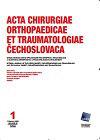[Management Strategy and Evaluation of Surgical Outcomes in Patients with Recurrent Patellar Instability between 2010-2020].
IF 0.4
4区 医学
Q4 ORTHOPEDICS
Acta chirurgiae orthopaedicae et traumatologiae Cechoslovaca
Pub Date : 2023-02-15
DOI:10.55095/achot2023/001
引用次数: 0
Abstract
PURPOSE OF THE STUDY The study retrospectively reviews the outcomes of patella stabilisation surgeries performed at our department in the period 2010-2020. It aimed to provide a more thorough evaluation, to compare the respective types of MPFL reconstruction and to confirm the beneficial effect of tibial tubercle ventromedialization on patella height. MATERIAL AND METHODS In the period 2010-2020, a total of 72 stabilisation surgeries of patellofemoral joint in 60 patients with objective patellar instability (OPI) were performed at our department. The surgical treatment outcomes were evaluated retrospectively using a questionnaire, including the postoperative Kujala score. A comprehensive examination was carried out in 42 patients (70%) who had completed the questionnaire. In case of distal realignment, the TT-TG distance and a change in the InsallSalvati index which serve as an indication for surgery, were assessed. RESULTS Altogether 42 patients (70%) and 46 surgical interventions (64%) were evaluated. The follow-up period was 1-11 years, with the mean follow-up of 6.9 years. In the studied group of patients, only 1 case (2%) of new dislocation was seen, in 2 cases (4%) the patients reported a subluxation episode. The mean score using the school grades was 1.76. Thirty-eight patients (90%) were satisfied with the surgical outcome, 39 patients would undergo a surgery in case of identical problems with the other limb. The mean postoperative Kujala score was 76.8 points, range 28-100 points. The mean TT-TG distance in the studied group with the preoperative CT scan (33x) was 15.4 mm (12-30 mm). The mean TT-TG distance in the cases indicated for tibial tubercle transposition was 22.2 mm (15-30 mm). The mean Insall-Salvati index prior to the performance of tibial tubercle ventromedialization was 1.33 (1-1.74). Postoperatively, the index decreased by 0.11 on average (-0.00 to -0.26) to 1.22 (0.92-1.63). No infectious complications were presented in the studied group. DISCUSSION In patients with recurrent patellar dislocation, the instability is often times caused by pathomorphologic anomalies of the patellofemoral joint. In patients with clinically expressed patellar instability and physiological values of the TT-TG distance, an isolated proximal realignment is performed by medial patellofemoral ligament (MPFL) reconstruction. In the case of pathological values of the TT-TG distance, distal realignment is performed by tibial tubercle ventromedialization to achieve physiological values of the TT-TG distance. In the studied group, tibial tubercle ventromedialization helped decrease the Insall-Salvati index by 0.11 points on average. This has a positive side effect on the patella height, thus on increasing its stability in the femoral groove. In patients with both proximal and distal malalignment, a two-stage surgery is performed. In the isolated cases of severe instability or if symptoms of lateral patellar hyperpressure are present, musculus vastus medialis transfer or arthroscopic lateral release are performed as well. CONCLUSIONS When correctly indicated, proximal, distal realignment or their combination can bring very good functional outcomes with a low risk of recurrent dislocation and postoperative complications. The importance of MPFL reconstruction is confirmed by low incidence of recurrent dislocation in the group investigated in this study, namely when compared with studies referred to in this paper, in which the patients underwent patellar stabilisation using the Elmslie-Trillat procedure. Conversely, leaving the bone malalignment untreated during the isolated MPFL reconstruction increases the risk of its failure. Judging from the obtained results, tibial tubercle ventromedialization also has a positive effect on the patella height through its distalization. Provided the stabilisation procedure is correctly indicated and performed, the patients can get back to their normal activities, often even sports activities. Key words: objective patellar instability, patellar stabilisation, MPFL, tibial tubercle transposition.[2010-2020年复发性髌骨不稳患者手术治疗策略及疗效评价]。
本研究回顾性回顾了2010-2020年期间在我科进行的髌骨稳定手术的结果。目的是提供更全面的评估,比较不同类型的MPFL重建,并确认胫骨结节腹内化对髌骨高度的有益影响。材料与方法2010-2020年,我科共对60例客观髌骨不稳(OPI)患者进行了72例髌股关节稳定手术。采用回顾性调查问卷评估手术治疗结果,包括术后Kujala评分。对42例(70%)完成问卷调查的患者进行全面检查。在远端复位的情况下,评估TT-TG距离和InsallSalvati指数的变化,作为手术的指征。结果42例患者(70%),46例手术干预(64%)。随访期1 ~ 11年,平均6.9年。在研究组中,仅有1例(2%)患者出现新脱位,2例(4%)患者出现半脱位。使用学校成绩的平均分数为1.76。38例患者(90%)对手术结果满意,39例患者在另一侧肢体出现相同问题时将进行手术。术后平均Kujala评分76.8分,范围28 ~ 100分。研究组术前CT扫描(33x) TT-TG平均距离15.4 mm (12-30 mm)。胫骨结节转位的TT-TG平均距离为22.2 mm (15-30 mm)。胫骨结节腹内化前Insall-Salvati平均指数为1.33(1-1.74)。术后指数平均下降0.11(-0.00 ~ -0.26)~ 1.22(0.92 ~ 1.63)。研究组未出现感染并发症。在复发性髌骨脱位患者中,不稳定常常是由髌股关节的病理形态学异常引起的。对于临床表现为髌骨不稳定和TT-TG距离生理值的患者,通过内侧髌股韧带(MPFL)重建进行孤立的近端重新调整。在TT-TG距离的病理值的情况下,通过胫骨结节腹中化进行远端重新定位,以获得TT-TG距离的生理值。在研究组中,胫骨结节腹中化使Insall-Salvati指数平均降低0.11点。这对髌骨高度有积极的副作用,从而增加其在股沟中的稳定性。对于近端和远端排列不一致的患者,需要进行两期手术。在严重不稳定的孤立病例中,如果存在外侧髌骨高压症状,也可以进行股内侧肌转移或关节镜下外侧松解。结论:如果指示正确,近端、远端复位或两者联合复位可带来良好的功能效果,且脱位复发和术后并发症的风险较低。本研究中所调查的组中复发性脱位的发生率较低,即与本文中使用Elmslie-Trillat手术对患者进行髌骨稳定的研究相比,证实了MPFL重建的重要性。相反,在孤立性强腓骨韧带重建过程中,不治疗骨不正会增加其失败的风险。从所获得的结果来看,胫骨结节腹中化通过其远端化对髌骨高度也有积极的影响。如果稳定过程得到正确指示和执行,患者可以恢复正常活动,通常甚至是体育活动。关键词:客观髌骨不稳,髌骨稳定,强韧带外突,胫骨结节转位。
本文章由计算机程序翻译,如有差异,请以英文原文为准。
求助全文
约1分钟内获得全文
求助全文
来源期刊
CiteScore
0.70
自引率
25.00%
发文量
53
期刊介绍:
Editorial Board accepts for publication articles, reports from congresses, fellowships, book reviews, reports concerning activities of orthopaedic and other relating specialised societies, reports on anniversaries of outstanding personalities in orthopaedics and announcements of congresses and symposia being prepared. Articles include original papers, case reports and current concepts reviews and recently also instructional lectures.

 求助内容:
求助内容: 应助结果提醒方式:
应助结果提醒方式:


